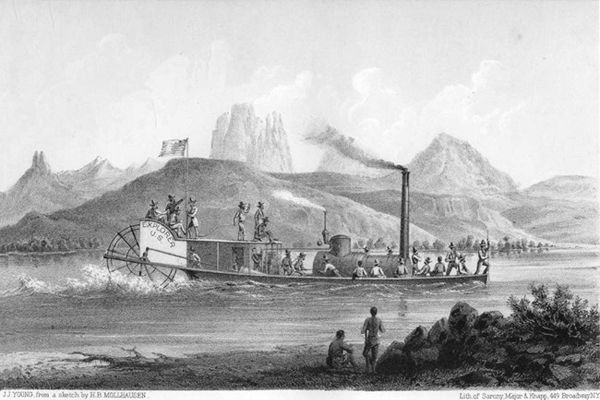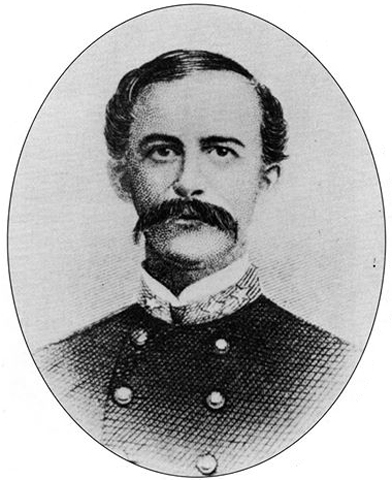Lieutenant Joseph Christmas Ives
Joseph Christmas Ives (1828–1868), soldier, botanist, explorer of the Colorado River in 1858.
Ives was born in New York City in 1828 and was a graduate of the United States Military Academy in 1852. As a Lieutenant
from 1853 to 1854 he was appointed by the U.S. Army to the Topographical Engineers as assistant to
Lt. A.W. Whipple
in the
Pacific Railroad survey along the 35th parallel.

From 1857 to 1858 Ives commanded an expedition to explore up the
Colorado River
from its mouth.
Report upon the Colorado river of the West
Title: Lieutenant Joseph Christmas Ives: A Soldier, Botanist, and Colorado River Explorer
Introduction:
Lieutenant Joseph Christmas Ives was a remarkable individual who left an indelible mark on history as a soldier, botanist, and explorer. Born in 1828, his life was dedicated to serving his country, advancing scientific knowledge, and venturing into uncharted territories. This blog post aims to shed light on the fascinating accomplishments of Lieutenant Joseph Christmas Ives, particularly his exploration of the Colorado River in 1858.
Soldier:
Lieutenant Ives began his career in the military, showcasing his courage and dedication to duty. He served in the United States Army Corps of Topographical Engineers, an elite group responsible for mapping and surveying the expanding American frontier. This experience laid the foundation for his future endeavors as an explorer.
Botanist:
While his military duties were essential, Lieutenant Ives also had a passion for the natural world. He possessed a keen interest in botany, the study of plants. He meticulously documented the flora he encountered along the way during his expeditions. His botanical findings contributed to scientific knowledge and highlighted the rich biodiversity of the regions he explored.
Explorer of the Colorado River:
One of Lieutenant Ives' most significant achievements was his exploration of the Colorado River. In 1858, he led an expedition to navigate the uncharted waters of this majestic river, which flowed through the rugged terrain of the American West. His primary objective was to determine the river's navigability and assess its potential for commercial transportation.
Accompanied by a team of skilled individuals, Lieutenant Ives embarked on this daring expedition. Despite facing numerous challenges, including treacherous rapids and unpredictable weather conditions, he persevered and successfully completed the journey. His expedition marked the first documented exploration of the Colorado River, providing invaluable information about its geology, ecology, and potential for development.
Legacy:
Lieutenant Joseph Christmas Ives' contributions to both military and scientific spheres cannot be overstated. His dedication to duty as a soldier and his passion for botany significantly influenced his explorations and the knowledge he brought back. Today, his expedition on the Colorado River is regarded as a landmark achievement in American exploration history.
Conclusion:
Lieutenant Joseph Christmas Ives was a true Renaissance man, excelling in multiple disciplines. His legacy as a soldier, botanist, and explorer lives on, inspiring future generations to push the boundaries of knowledge and expand our understanding of the world. His exploration of the Colorado River remains a testament to his courage, determination, and unwavering pursuit of discovery. Lieutenant Ives' contributions have left an everlasting impact on the fields of science and exploration, and his name will forever be associated with the rich history of the American West.

Also see:
Beale Expedition
When, under orders from the Secretary of War, Lt. Joseph C. Ives, earlier with the Whipple Expedition, arrived at the mouth of the Colorado River with the ...
Chemehuevi, Mohave & Cahuilla Indians
Whipple and Ives, for the sake of some new and curious acquaintance-for which we shall be indebted to those intelligent and experienced path-finders-with ...
Indians of the Mojave Desert
Tribes of the 35th Parallel. Let us accompany Messrs. Whipple and Ives, for the sake of some new and curious acquaintance-for which we shall be . ...
Whipple Expedition
The Whipple Expedition, a large scientific expedition led by Lt. Amiel Weeks Whipple, Brevet Lt. J. C. Ives, and 2nd Lt. D. S. Stanley, which was the next ...
Military & Pioneer Period - Mohave Indians
The Whipple Expedition, a large scientific expedition led by Lt. Amiel Weeks Whipple, Brevet Lt. J. C. Ives, and 2nd Lt. D. S. Stanley, which was the next ...
Amiel Whipple
In 1858 Lieutenant Ives named a mountain range along the west bank of the Colorado River for Amiel W. Whipple. These mountains lie east to west in what is ...
Lake Mead
In 1855, Lt. Joseph Christmas Ives traveled the lower Colorado River in search of ... Following Ives, John Wesley Powell continued exploration of the upper ...
History of Hoover Dam
River explorers and mappers first came in January, 1858, under the leadership of Lt. Joseph Christmas Ives, who came up the Colorado by steamboat from the ...
Hoover Dam Chronology
Lt. J. C. Ives navigates the Colorado River and, with his steamboat The Explorer , reaches the end of Black Canyon. 1869. Major John Wesley Powell makes the ...